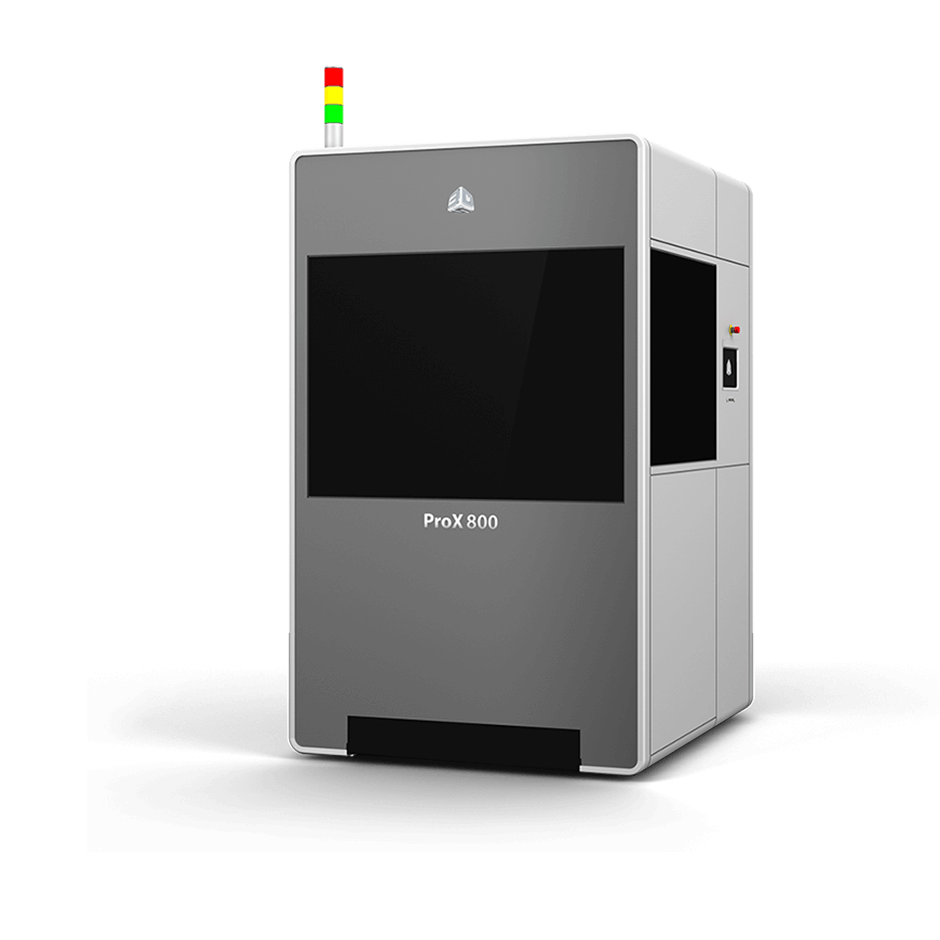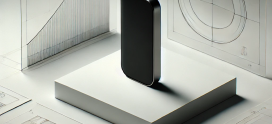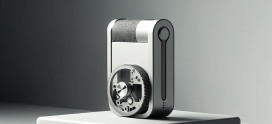
Innovative Surgery Guided by 3D Printing Alleviates Pain for Champion Sled Hockey Player
Firefly surgical technology in partnership with 3D Systems Healthcare and 3D printing delivers faster, simpler way to accurately place screws around critical areas during surgery.
When Mark Weimer emerged from the fog of pain medication after major spinal surgery, he didn’t think about how he was feeling. He thought about what he wasn’t feeling: the pain in his quad muscles, emanating from his lower spine, that had plagued him for a year and a half.
The relief was the result of a 15-hour operation by Dr. George Frey that combined his award winning methodology for pedicle screw navigation with 3D imaging and printing technologies pioneered by 3D Systems.
Partnering for the patient’s benefit
Dr. Frey and his wife, Heidi, head up Mighty Oak Medical in Englewood, Colorado. The company’s patented FIREFLY® technology provides a simpler and faster way to accurately place pedicle screws for spinal repair while navigating around crucial anatomy such as the spinal cord, nerves and blood vessels.
From the beginning, Mighty Oak has teamed with the 3D Systems Healthcare Team in nearby Littleton, Colorado.
“We needed a 3D printing partner that was known for quality, reliability and expertise in the medical device space,” says Heidi Frey. “3D Systems has been an amazing partner at every level—they are supportive, responsive and dedicated to excellence.”
3D Systems offers an end-to-end suite of precision healthcare solutions, including virtual reality simulators, 3D printed anatomical models, and patient-specific surgical guides and instrumentation. The company also manufactures precision 3D printed medical devices.
Since the late 1990s, 3D Systems has partnered with medical device providers representing a wide variety of procedures for nearly every aspect of human anatomy. The company has developed personalized solutions for more than 100,000 surgical procedures.
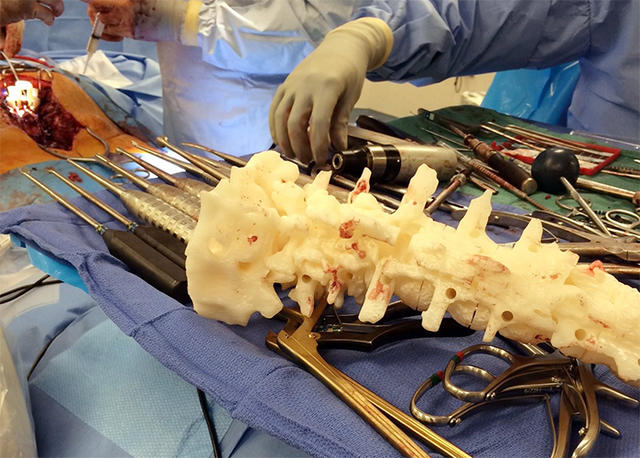
Path of a champion
Dr. Frey was connected to Mark Weimer through his neuro surgeon who has treated Weimer since his initial operation after a fall from construction scaffolding partially paralyzed him in 1984. Weimer later underwent an additional spinal fusion surgery in 2001 to help correct loss of muscle strength in his right arm.
Following his injury and initial surgery, Weimer took advantage of a computer training grant to become an IT specialist in data warehousing. He also continued to pursue his love of hockey, joining a Colorado sled hockey program in 1996.
Weimer played on the 2000 national sled hockey team in Lake Placid, home of the famous “Miracle on Ice” victory of the U.S. hockey team over Russia in the 1980 Winter Olympics. In 2010, he captained the team that won the Sled Classic Championship sponsored by the National Hockey League (NHL), and the following year he starred on the Colorado Avalanche team that captured the 2011 National Sled Hockey Championship sponsored by USA Hockey.
Weimer retired after scoring a goal and an assist in the 2011 championship. He turned to coaching young sled hockey players and has stayed in shape by hand cycling. His hockey achievements were recognized by his induction into the Colorado Adaptive Sports Foundation Hall of Fame in 2012.
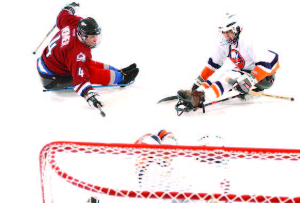
Mark Weimer won multiple sled hockey championships on his way to the Colorado Adaptive Sports Foundation Hall of Fame.
A complicated case
Since his accident, Weimer had always dealt with some level of nerve and spinal discomfort, but in late 2014 he started experiencing something new: severe pain in his quad muscles, along with bowel and bladder problems. Weimer’s neurosurgeon referred him to Dr. Frey for further examination.
“As the years went by, Mark’s spinal fusion and his neurological condition caused the remaining discs and vertebrae below the fusion to deteriorate,” says Dr. Frey. “This caused further compression of the nerves and spinal cord, resulting in severe neuropathic pain.”
Preparation for surgery started with a CT scan of Weimer’s spine. The results were sent to 3D Systems, which performed data segmentation to extract a 3D representation of Weimer’s spinal anatomy.
Weimer’s case was more complex than most other spinal procedures, according to Dr. Frey and Chris Beaudreau, Director of Medical Services at 3D Systems.
“Mark had bone growth over the rods inserted from his previous surgery,” says Dr. Frey. “Although the rods were being removed, any disruption to the surrounding bone could affect the placement of the FIREFLY guides, so plenty of planning was needed to work around the anatomy.”
“Due to his previous surgical procedures, there were significant imaging artifacts within the CT scan that required extensive medical image processing in order to render the anatomical area of interest into three-dimensional digital models,” says Beaudreau. “It was also going to be an extensive spinal procedure, so instead of modeling two or three vertebrae, we needed to process nine vertebrae, the sacrum bone at the base of the spine, and both hips.”
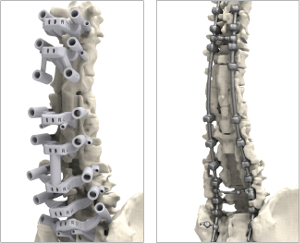
The renderings show custom, patient-specific guides for screw placement that allow the surgeon to safely avoid vital, complex spinal anatomy. In total, 10 guides were manufactured for Mark Weimer’s operation, each designed for a specific vertebral body. Once guides are in position, screws can be placed with a high degree of accuracy.
The image on the left shows the surgical guides in place on the patient’s anatomy, before the hardware was affixed.
The image on the right shows the post-operative placement of the spinal hardware.
3D printing from the source
3D Systems sent the 3D models of Weimer’s spinal anatomy to Mighty Oak Medical, which used them to design the trajectory of each pedicle screw and to prepare the 3D printed guides that would determine accurate screw placement on Weimer’s spine.
Using the FIREFLY design, 3D Systems printed pedicle screw guides for each vertebra that required operation. An anatomical bone model was also printed for pre-surgical planning and reference in the operating room.
The surgical guides and bone models were printed on a 3D Systems ProX® 800, a stereolithography (SLA) system known for building parts with outstanding surface smoothness, feature resolution, edge definition and tolerances.
SLA technology was invented by 3D Systems co-founder Chuck Hull in 1983. The company continues to innovate with the technology, lowering costs while delivering ever-greater speed, capacity, accuracy and ease-of-use.
The ProX 800 offers a wide range of materials for the broadest applications and use cases. For Weimer’s reference model and screw guides, 3D Systems used a plastic material and validated process that allows parts to be sterilized for use directly in the operating room.
Surgical success and recovery
Dr. Frey operated on Mark Weimer at Swedish Medical Center in Englewood on July 22, 2016. When Weimer resumed consciousness, his most recent pains were gone and previous pains had lessened considerably.
“Mark is currently undergoing a rigorous rehabilitative process and is recovering nicely from his fusion surgery,” says Dr. Frey, who expects the recovery period to last about a year.
At 63, Weimer continues to work in the IT field and pursue hand cycling in his free time. He also enjoys watching his grandsons, ages 9 and 13, take his place on the ice as the next generation of champions.
Source by https://3dsystems.com

